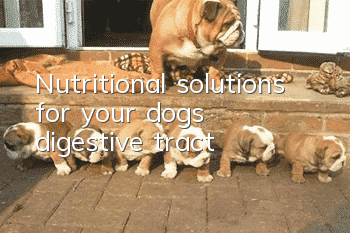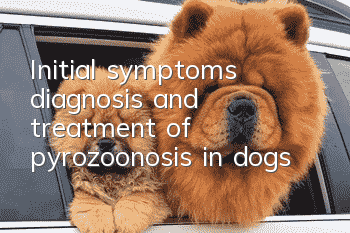Nutritional solutions for your dog’s digestive tract

The digestive tracts of dogs and cats are similar in other aspects except for their different lengths. The average intestinal length of a dog with a body length of 0.75m is 4.5m. The average intestinal length of a cat with a body length of 0.5m is approximately 2.1m. The length of the intestine is a factor that affects the residence time of nutrients in the digestive tract, and therefore also affects digestion. time.
The digestive tract of dogs and cats has a large absorption area due to the presence of intestinal villi, thus speeding up the digestion of nutrients. The intestinal area per centimeter of intestine is similar in dogs and cats.
The biggest difference between the gastrointestinal tracts of dogs and cats is that the mucosa in the front part of the dog's stomach is thinner and has obvious gastric glands, while the mucosa in the tail part of the stomach is thicker but the gastric glands are not obvious. The gastric mucosa of dogs and cats can be divided into a narrow part of the glandular mucosa of the spout and a wide part of the glandular mucosa of the pylorus. There are glandular areas in the spout and pylorus that secrete mucus and bicarbonate. Certain glandular areas secrete hydrochloric acid and pepsinogen. Felines compared to canines. The gastric mucosa is uniform and uniform. The dog's cecum is a curved appendage located at the distal end of the ileocecal valve, but the cat's cecum is not curved.
The digestion process is the comprehensive result of physical digestion, chemical digestion and microbial digestion. These three digestion methods enable the diet to be continuously degraded and digested. Chewing and digestion-related muscle contractions are physical digestions that reduce the particle size of ingested food. Enzyme-rich digestive juices are secreted into chyme in the stomach and small intestine, promoting chemical digestion. Microorganisms that colonize the end of the digestive tract also secrete certain enzymes to chemically digest food components that are not digested by the earlier parts of the digestive tract. Autonomous and involuntary control of gastrointestinal activity. Ingestion, chewing and swallowing are all consciously controlled by the individual. After swallowing, digestive functions starting in the back of the mouth are reflex activities. When food passes through the throat from the esophagus into the stomach, the sphincter relaxes and contracts under the unconscious control of cranial nerves. When food enters the stomach, the stomach muscles produce a relaxation reflex. to counteract the increase in intragastric pressure. The secretion of all digestive juices and the movement of the digestive tract in the gastrointestinal tract are controlled by both nerves and hormones. The movement of the digestive tract pushes chyme toward the end of the intestine in the form of peristaltic waves.
Comparative studies of dog and cat digestion show that dogs and cats are closely related in terms of their intestinal characteristics, natural wild foods, and nutritional needs. Cats originate from a family of animals that are entirely carnivorous, while dogs are omnivorous.
The digestive process begins in the mouth. Saliva is secreted by four pairs of salivary glands when chewing food. The parotid glands are located in front of the ears and the palatine glands are located on the underside of the mandible on each side. The sublingual glands are located at the base of the tongue, and the orbits are located on the roof of the mouth below the eyes. The same goes for the distribution of glands in cats. Seeing and smelling food increases saliva production, and the type and water content of the food consumed affects the amount and composition of saliva. The submandibular and sublingual glands secrete large amounts of mucus, and the otoparotid glands secrete serous fluid. The main inorganic ions in saliva are sodium, potassium and chloride. They come from plasma, while bicarbonate is secreted by slimming cells. flow rate in salivaUnder higher conditions, the osmotic pressure of saliva secreted into the oral cavity by dogs and cats is the same, and the sodium-potassium ratio is similar to that in plasma, but the ratio of bicarbonate to chloride ions and the pH are higher than those in plasma. However, at low salivary flow rates, the absorptive nature of the tubular cells reduces the osmotic pressure, sodium-to-potassium ratio, chloride and bicarbonate concentrations and pH of saliva reaching the oral cavity. The pH of dog saliva is 7.34~7.80, while the average pH of cat saliva is 7.5. Like many species, dogs and cats lack the enzyme amylase in their saliva that can digest starch.
Another important function of dog saliva is evaporation and heat dissipation. Under the strong stimulation of parasympathetic nerves, the secretion speed of dog parotid glands is 10 times that of humans. The permeability of saliva increases with increasing flow rate, and at maximum flow rates it is an almost isotonic solution. Article source: Pet Information Service Center public account
- Is it possible to cure a dog’s parvovirus?
- The whole process of dog breeding
- How do dogs remove dental calculus? Do you really know?
- Symptoms of conjunctivitis in dogs
- Does your Border Collie bite things randomly? Reduce the destructive power of your Border Collie!
- What should I do if my German Longhaired Pointer eats too much and has diarrhea?
- What are the symptoms of pancreatitis in dogs?
- What should I do if my Akita dog vomits clear liquid? There are tips for treating vomiting in Akita dogs
- My dog doesn’t seem to have enough to eat. Does he need extra food?
- What should you pay attention to in your dog’s diet?



